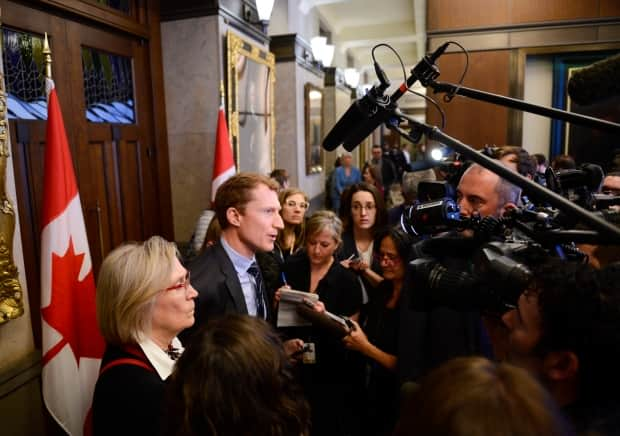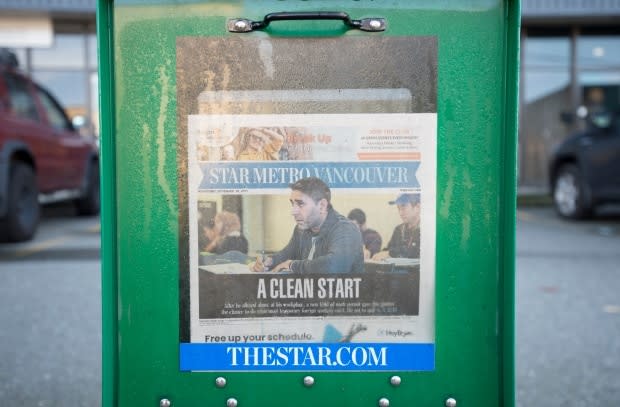Financially struggling newspapers to get federal money within weeks, heritage minister says
Federal Heritage Minister Steven Guilbeault says he expects money from an emergency COVID-19 general business wage subsidy program to start flowing within weeks to Canada's beleaguered newspaper industry.
Critics say this financial lifeline may come too late, however, to save the pandemic crisis-accelerated loss of newspapers and media jobs — specifically, because a $595-million financial-assistance program first announced 18 months ago has yet to provide any money to increasingly desperate newspaper publishers.
"That is a very long time to wait for the newspaper business when newspapers are closing almost every week," said Winnipeg Free Press publisher Bob Cox, who is also chair of the Canadian News Media Association, an industry lobby group, earlier this month.
Cox said he doesn't know exactly how many newspapers have closed since the pandemic began but that it has been dozens, including more than 20 in the Maritimes. At least six publications in Quebec have dropped Monday-to-Friday print editions, and four have closed in Manitoba.
Québecor, which owns the Journal de Montréal, Vidéotron and other media properties, announced at the end of March that it would temporarily lay off 10 per cent of its workforce. And Postmedia, the country's largest newspaper publisher, was considering temporary salary cuts to stave off COVID-19 losses, according to a report in The Tyee.
Postmedia announced April 28 it would close 15 weeklies in Manitoba and southern Ontario in May, because the papers were losing money and faced further declines in advertising sales in the pandemic.
Cox said advertising revenues are generally down about 50 per cent.
"On an annualized basis, that would be more than $1 billion [in lost ad revenues] for the whole industry in Canada," Cox said. "No one knows how long the COVID impact will be. My estimate for industry losses related to COVID in 2020 is at least $500 million.

Edward Greenspon, president of the non-profit Public Policy Forum in Ottawa, said daily ad revenues for newspapers have fallen two-thirds in 12 years from from $2.7 billion in 2007 to about $900 million last year. He said ad revenue for weekly newspapers fell by about half during that same period.
The pandemic, "will certainly take a huge bite out of that," said Greenspon, who was editor-in-chief of the Globe and Mail from 2002 to 2009 and co-authored Shattered Mirror, a report into the state of Canada's newspaper industry produced by the Public Policy Forum.
Cox said the $595-million in federal funding, which includes a series of tax measures and was included in the 2019 budget, already has been overtaken by the COVID-19 pandemic.
The government money is supposed to offset advertising revenue lost to internet giants such as Google and Facebook and help pay to keep journalists employed.
"But then COVID came along, and everything changed," Cox said. "Now, we have lost a lot of our advertising revenues as well. So really, we have got to talk about a new way of supporting newspapers and the news media industry in general."
Temporary handouts not the solution
Cox said there has to be a way to build sustainable business models that will allow news outlets to provide news to communities and pay employees a decent wage.
"We don't really want temporary government handouts. That is not the best route."
Cox said he has spoken with Heritage Ministry officials, for example, about adopting legislation now being proposed in Australia that would force Google and Facebook to pay for media content they carry.

Another proposal is to raise the tax credit on digital news subscriptions from 15 per cent to 50 per cent to encourage more people to support Canadian media outlets.
Sean Holman, a journalism professor at Mount Royal University in Calgary, said he wouldn't argue against financial support for the newspaper industry in the midst of a growing crisis. But he said newspapers contributed to the economic problem, because they failed to adapt to a changing cultural and digital media environment.
For years, even as their advertising declined, newspapers viewed their job as delivering readers to advertisers, he said. And too often, they did that by producing "clickbait" stories that generated page views but not reader loyalty.
Creating communities
"If your focus is always on getting the story that is going to get big clicks, then that doesn't leave a lot of room to show readers the kind of value that you can provide from a public interest standpoint," Holman said.
"I think newsroom leaders in this country need to be thinking about how to create communities around their publications that are willing to invest in those publications either as donors or subscribers," he said.
Newspapers, Holman argues, don't have an economic problem; they have a culture problem.
"The longer the Canadian news media persists in believing that it's an economic problem, the longer it will be an economic problem for them."
In an interview with CBC News last week, Guilbeault said the government is cognizant of both the importance of newspapers during the COVID-19 crisis and the heightened existential crisis for the industry caused by the pandemic.
"Clearly, we are trying to get the money out the door as quickly as possible," Guilbeault said, referring to the wage-subsidy program.
"Our goal is that the news media can start getting their checks as of August or September. We're not sure we will be able to make it. But that is what we're working really hard to achieve."

Guilbeault also pointed to changes announced earlier this month by the federal Finance Department that allow publishers of magazines and non-daily newspapers that receive support through the Canada Periodical Fund to qualify for the Canadian journalism labour tax credit.
The tax credit program offers a 25 per cent tax credit and is retroactive to Jan. 1. 2019.
Many journalists wary of funding
The government, Guilbeault said, is also spending $30 million on a COVID health advertising campaign, with 90 per cent of that money directed to nearly 900 Canadian media outlets, many of which are community newspapers.
Many journalists, however, are wary of the government funding journalism. Karyn Pugliese, president of the Canadian Association of Journalists, said there needs to be more transparency and accountability around the funding.
"We want to know, for example, everybody who is applying for this money, and we want to have accountability of how it's being used," Pugliese said.

As it stands, newspaper companies can take federal money and still lay off employees.
This accountability is needed "not just for the survival of the industry financially but for the survival of the appearance of independence, and the true independence of the industry," Pugliese said.
The CAJ, she said, also wants to ensure "that government can't just cut funding when they don't like what you're covering."
Some in the newspaper industry have accused the CBC of undercutting newspapers through the broadcaster's publicly subsidized expansion into digital news since 1996.
But Cox and Guilbeault say CBC is a potential ally for newspapers. Guilbeault pointed to a pilot project in which CBC Winnipeg and the Winnipeg Free Press have formed a partnership to promote each other's journalism on their websites on weekends.
Cox said the experiment is small but that these kinds of partnerships "are going to be more and more necessary as the news media becomes more fragile."
"We have to work together to make sure our communities are served," he said.

Print still in demand in rural Canada
Guilbeault said he would like to see more local media partnering with CBC and using its platform, which is federally funded, to make local journalism more widely available across the country.
Roger Holmes is a third-generation community newspaper publisher in Wainwright, Alta., near the Alberta-Saskatchewan border. He published the Wainwright Star.
Holmes said he is uneasy about accepting money from the federal government since the media would have to "bite the hand that is feeding it."
He would prefer that the government instead funnel the money it's now spending on internet ads to print publications, which are still in demand in rural Canada.
LISTEN | How small Alberta newspapers are handling a drop in ad revenue:
Printer: 'I'm the bad guy'
Still, Holmes acknowledges that federal money is needed now to halt the rapid failure of local newspapers because of the COVID-19 crisis. His family also owns a commercial press that before the pandemic printed 50 community newspapers for independent publishers from Alberta and Saskatchewan.
"I'm the bad guy, because I want to get paid every week and, for some of them, I have had to stop printing their papers because they were not able to pay me," Holmes said.
"A lot of them are down to skeleton crews. Some of them just one or two employees or mothers and husbands and wives. So, it's desperate," he said.
Cox points out that even as newspapers are failing during the pandemic, readership has soared.
"We don't have an audience problem. We have a revenue problem," Cox said.
Where to next?
"There is demand for what we do, and there are a lot of people who appreciate what we do as a public service in the public interest.
"And I think that should be proof enough that we are deserving of some government attention."
Holmes remembers his father talking about tough times in the news business during the 1920s and the Depression of the 1930s.
Now, he's witnessing the "hollowing out" of newspapers, first through the massive loss over the past few years of advertising revenue to internet giants Google and Facebook, and now through the COVID-19 crisis.
"We're just kind of wondering where do we go next," said Holmes.


